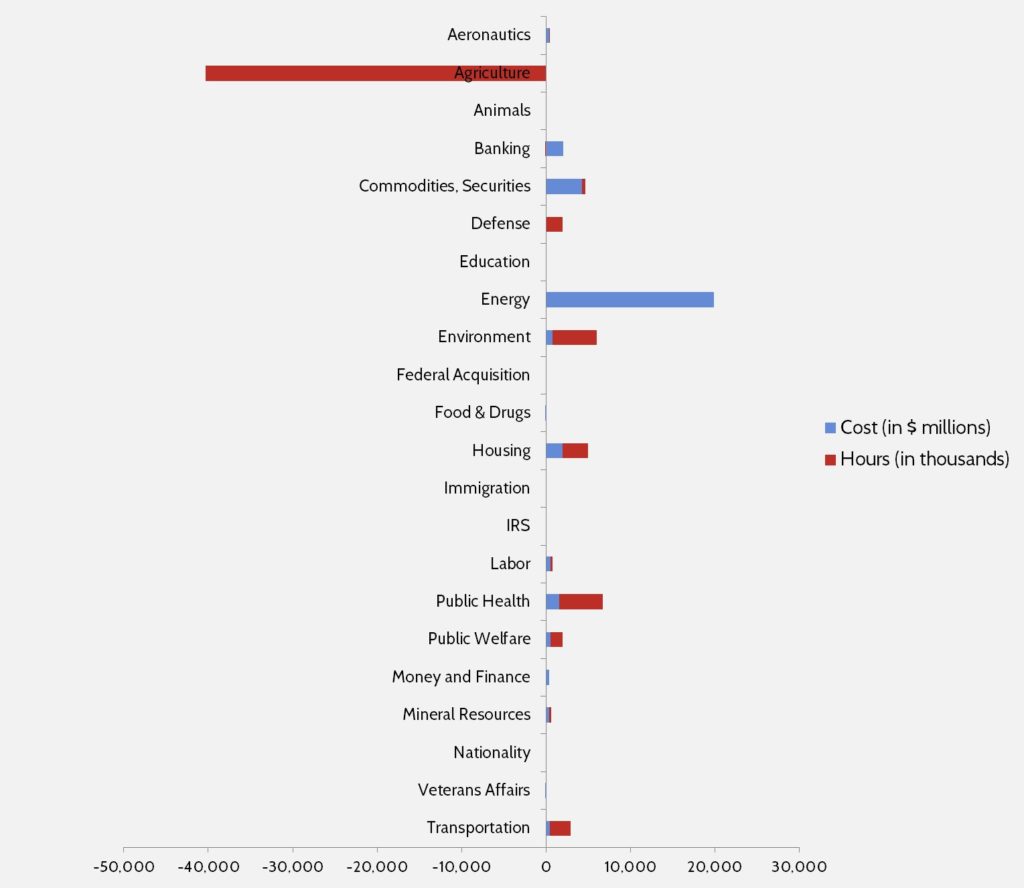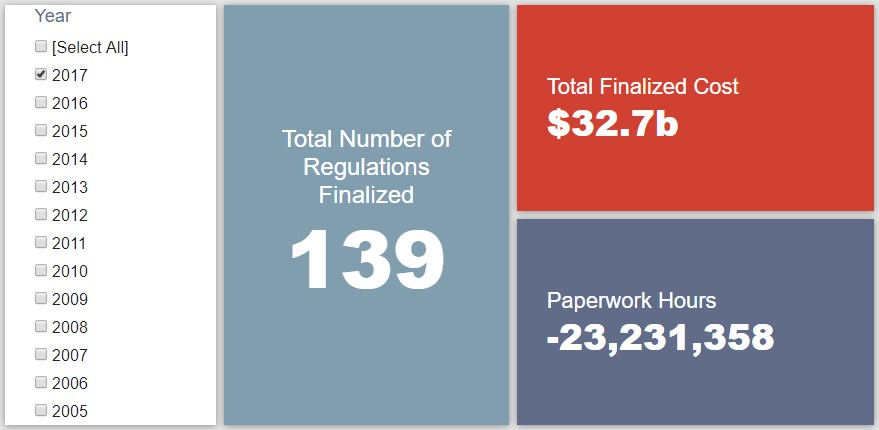Week in Regulation
July 31, 2017
Deregulatory Actions Developing
In a moderately busy week on the regulatory front, it was actually deregulatory measures that drove most of the week’s action. Out of the 14 rulemakings with some cost or paperwork estimate, five would reduce burdens by more than $390 million in costs and roughly 620 thousand hours of paperwork. The remaining actions bring only $13 million and 76 thousand paperwork hours in new burdens. The per capita regulatory burden for 2017 is $458.
Regulatory Toplines
- New Proposed Rules: 38
- New Final Rules: 75
- 2017 Total Pages of Regulation: 35,370
- 2017 Final Rules: $32.7 Billion
- 2017 Proposed Rules: $113.9 Billion
The American Action Forum (AAF) has catalogued regulations according to their codification in the Code of Federal Regulations (CFR). The CFR is organized into 50 titles, with each title corresponding to an industry or part of government. This snapshot of final rules (a change from earlier versions) will help to determine which sectors of the economy receive the highest number of regulatory actions.
There were three particularly notable proposed rules that could add to the deregulatory ledger established by Executive Order (EO) 13,771. The most significant action was the proposed “Re-codification” of the “Waters of the United States” (WOTUS) rule. According to the Economic Analysis, changing WOTUS regulation back to its pre-2015 status could bring nearly $314 million in annual avoided costs but also forgo at least $44.5 in annual benefits. The other two substantial deregulatory actions include: a Department of Energy proposal that would save upwards of $34 million annually by rescinding the 2015 rule on hydraulic fracturing (commonly know as “fracking”), and a Centers for Medicare & Medicaid payment rule that, among other things, would remove certain reporting requirements thereby reducing annual burdens by $44.9 million and 620,896 paperwork hours.
Tracking Regulatory Modernization
The aforementioned deregulatory actions were the most significant of the week. However, since they are still proposed rules, they technically do not apply to the final EO 13,771 tally. Although there was a pair of final rules from the Fish & Wildlife Service that cut burdens under the EO (both, incidentally, deal with migratory bird issues). The first one handles “Use of Inedible Bird Parts in Authentic Alaska Native Handicrafts for Sale” and estimates “net benefits” of $362,200 under EO 13,771. The second would save $6,726.72 by reducing burdens imposed by, “depredation permits … to address the cattle egret and barn owl issues in Hawaii.”
On regulatory budget implementation, below are the agencies that have accrued annual savings or new costs under the president’s one-in, two-out budget; proposed rules are not included:
- Defense: -$400 million
- Interior: -$360.37 million
- Education: -$100 million
- Labor: -$78 million
- Veterans Affairs: -$1.9 million
- HHS: -$8.4 million
- EPA: $60 million
- Energy: $34 million
Many of these figures are the result of CRA resolutions of disapproval. Given their historic regulatory output, AAF can predict that Defense, Interior, and Education will likely meet the goal of $0 in net regulatory costs by the end of this fiscal year.
Affordable Care Act
Since passage, based on total lifetime costs of the regulations, the Affordable Care Act has imposed costs of $53 billion in final state and private-sector burdens and 176.9 million annual paperwork hours.
Dodd-Frank
Click here to view the total estimated revised costs from Dodd-Frank; since passage, the legislation has produced more than 74.8 million final paperwork burden hours and imposed $38.9 billion in direct compliance costs.
Total Burdens
Since January 1, the federal government has published $146.6 billion in compliance costs ($32.7 billion in final rules) and has cut 18 million paperwork burden hours (due to 23.2 million in reductions from final rules). Click below for the latest Reg Rodeo findings.












